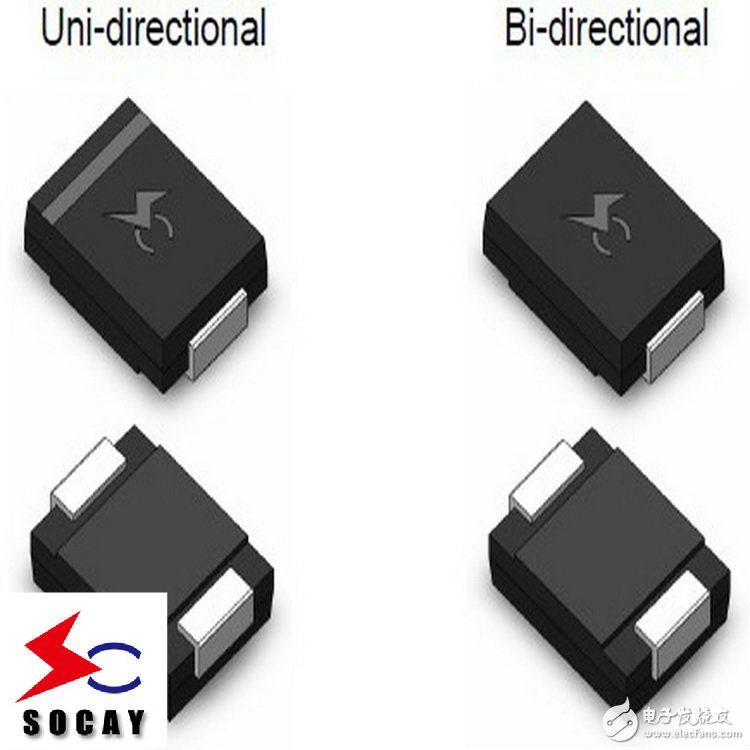Once it is confirmed that the customer's products need to prevent excessive voltage and transient surges, Xiaoshuo believes that most engineers will give priority to testing whether TVS transient suppression diodes can meet the protection needs of customers' products. DC protection generally uses one-way TVS tube, AC protection generally uses two-way TVS tube, multi-channel protection selects TVS array device, and high-power protection selects TVS special protection module. However, compared to other direct selection applications for circuit protection devices, TVS diodes still distinguish between single and bidirectional before testing. Although the final effect is the same, the range of application of single bidirectional TVS diodes is different. Bidirectional TVS tubes are suitable for AC circuits, and unidirectional TVS tubes are generally used for DC circuits. Novice engineers can't quickly distinguish the single bidirectional of TVS diodes when they first contact TVS diodes. This article is based on SOCAY Shuoke FAE engineers dictating a single bidirectional data to quickly distinguish TVS transient suppression diodes to SOCAY. Sokyo DO-214AB package SMCJ series SMCJ200CA as an example. Parameters of SMCJ200CA: Package: DO-214AB Voltage: 200.0V Current: 4.60A Clamping voltage: 324.0V Power: 1500W Features of SMCJ200CA: 1. Optimize board space for surface mount applications 2, low leakage 3, one-way and two-way unit 4, glass passivated junction 5, low inductance 6, excellent clamping ability 7, 1500W peak power capability at 10 & TImes; 1000μ waveform repetition rate (duty cycle): 0.01% 8, fast response time: from 0 volts to a minimum breakdown voltage is usually less than 1.0ps 9. Typically, when the voltage is higher than 12V, the reverse leakage current is less than 5μA. 10, high temperature welding: terminal 260 ° C / 40 seconds 11. Typical maximum temperature coefficient △Vbr =0.1% x Vbr@25°C x △T 12, plastic packaging has insurance company laboratory flammability 94V-0 13, lead-free plating tin 14, non-halogenated, RoHS compliant 15. A typical failure mode occurs at a specified voltage or current. 16. Whisker testing is based on JEDEC JESD201A for each of Tables 4a and 4c. 17, IEC-61000-4-2 ESD 15kV (air), 8kV (contact) 18. The ESD protection of the data line complies with IEC 61000-4-2 (IEC801-2) 19. The EFT protection of the data line complies with IEC 61000-4-4 (IEC801-4) 1. Look at the model number. From the surface of the model, we can judge that although different brands are named differently, they all have the same rules: 2, look at the specification, generally on the first page. <1> Two-way is two-way, <2> one-way is one-way, 3, with a multimeter <1> Measure the gear position of the diode, one-way one-way, both sides have voltage; <2> Measure DC, two-way symmetry, only one of the unidirectional reverse direction is avalanche breakdown characteristics, generally measured at 1 mA. 4. All TVS tubes will have a root cathode line after amplification. It is used to distinguish the positive and negative poles of the diode, and has nothing to do with single bidirectional. 1. One-way use in DC. Bidirectional for AC; one-way tvs protection device can only protect positive or negative pulses, while bidirectional tvs protection device has one end connected to the line to be protected, one end is grounded, whether it is from the reverse or from the forward ESD pulse Released to protect the IC more effectively. 2. The TVS tube has one-way and two-way points. The forward characteristic of the unidirectional TVS tube is the same as that of the ordinary Zener diode. The hard breakdown of the "right angle" at the reverse breakdown point is a typical PN junction avalanche. When there is a transient overvoltage pulse, the current of the device increases sharply and the reverse voltage rises to the clamp voltage value and remains at this level; the VI characteristic curve of the bidirectional TVS tube is like two unidirectional TVS "back to back" combination It has the same avalanche breakdown characteristics and clamping characteristics in both the positive and negative directions. The symmetric relationship between the front and back breakdown voltages is 0.9 ≤ VBR (positive) / VBR (reverse) ≤ 1.1. Once the interference voltage applied across it exceeds the clamp voltage Vc, it is immediately suppressed. 3. Interelectrode capacitance Cj One-way is larger than two-way. Take LRC as an example. One-way capacitor C has 65 PF, and two-way has only 15 PF. 4. Both sides of the USB data line are used; 5. The current curve is different. The circuit symbol of the unidirectional TVS tube is the same as that of the ordinary Zener tube, and its forward characteristic is the same as that of the ordinary diode, and the reverse characteristic is a typical PN junction avalanche device. Both the forward and reverse directions of the bidirectional diode are typical PN junction avalanche devices. From the market point of view, the two-way application of TVS tube is wider, and there is basically no difference in the unit price of the product. The lower the critical parameter capacitance C is, the better, which leads to the use of two-way TVS tubes in the electronics market and small factories. However, through the above analysis comparison, there are many differences between one-way and two-way. In many places, two-way can be used for two-way, but the most important one is to look at the circuit design of the project, and some can only use one-way TVS. Usb Fan,Mini Usb Fan,Usb Rechargeable Fan,Portable Usb Fan Foshan Shunde Josintech Electrical Appliance Technology Co.,Ltd , https://www.josintech.com